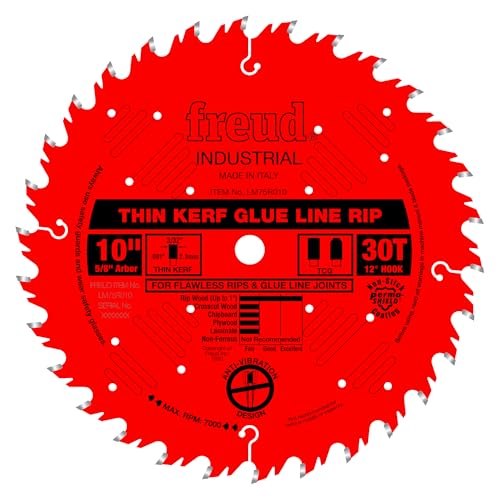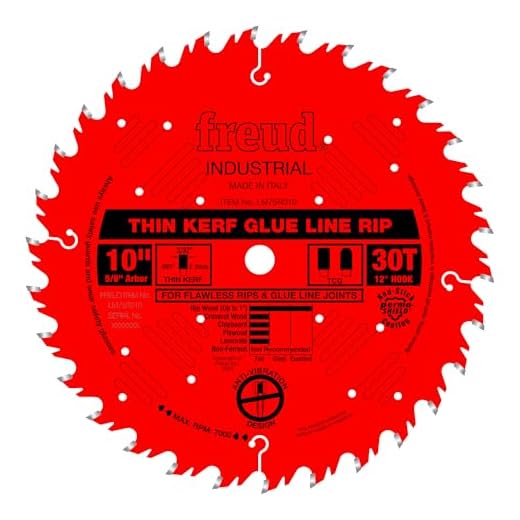




When it comes to cutting wood flooring, having the right circular saw blade is crucial. With so many options available, it can be overwhelming to choose the right one. However, understanding the different types of tooth configurations can help you make an informed decision.
One of the most important factors to consider when selecting a circular saw blade for cutting wood flooring is the tooth count. The number of teeth on a blade determines how smooth and clean the cut will be. Blades with lower tooth counts are ideal for ripping cuts, while those with higher tooth counts are better suited for crosscuts and fine cuts.
For cutting wood flooring, a blade with a high tooth count is recommended. These blades typically have between 60 and 80 teeth, which allows for clean and precise cuts. The high tooth count ensures minimal tear-out and reduces the need for additional sanding or finishing.
Additionally, it is important to consider the tooth configuration of the blade. Blades with alternate top bevel (ATB) or triple-chip grind (TCG) tooth configurations are commonly used for cutting wood flooring. The ATB configuration provides clean and smooth cuts, while the TCG configuration is ideal for laminate and engineered wood flooring.
In conclusion, when selecting a circular saw blade for cutting wood flooring, it is crucial to choose one with a high tooth count and the appropriate tooth configuration. This will ensure clean, smooth cuts and minimize the need for additional finishing. By considering these factors, you can confidently tackle your wood flooring project with ease.
Understanding the Circular Saw Blade
A circular saw blade is an essential tool for cutting wood floors. Understanding the different types of circular saw blades can help you choose the right one for your specific needs.
There are two main types of circular saw blades: rip blades and crosscut blades. Rip blades are designed for cutting wood along the grain, while crosscut blades are used for cutting across the grain.
When choosing a circular saw blade for cutting wood floors, it is important to consider the number of teeth on the blade. The number of teeth affects the speed and quality of the cut. Blades with fewer teeth are ideal for fast, rough cuts, while blades with more teeth provide a smoother, cleaner cut.
The size of the teeth on a circular saw blade is also important. Coarse teeth are ideal for cutting softwoods and rough lumber, while finer teeth are better suited for hardwoods and finished lumber.
Another factor to consider is the type of material the blade is made of. Carbide-tipped blades are the most common and durable option for cutting wood floors. They are designed to withstand the high speeds and heat generated by the saw.
In summary, when choosing a circular saw blade for cutting wood floors, consider the type of cut (rip or crosscut), the number and size of teeth, and the material of the blade. By understanding these factors, you can select the right blade for your specific needs and achieve the desired results.
Choosing the Right Tooth Configuration
When it comes to cutting wood floors, choosing the right tooth configuration for your circular saw blade is crucial. The tooth configuration determines the type of cut you will achieve and the speed at which you can cut through the wood. There are different tooth configurations available, each designed for specific purposes. Let’s take a look at some of the common tooth configurations and their recommended uses.
Rip Tooth Configuration
The rip tooth configuration consists of flat-topped teeth that have large gullets. This configuration is ideal for making cuts along the grain of the wood, such as when you are ripping boards to width. The large gullets help remove the wood chips efficiently, allowing for fast and efficient cutting.
Crosscut Tooth Configuration
The crosscut tooth configuration features an alternating pattern of beveled teeth. This configuration is suitable for making cuts across the grain of the wood, ensuring a clean and smooth finish. The beveled teeth create a shearing action, which helps to minimize tear-out and splintering.
| Tooth Configuration | Recommended Use |
|---|---|
| Rip | Cuts along the grain, ripping boards to width |
| Crosscut | Cuts across the grain, ensuring a clean and smooth finish |
In addition to these two common tooth configurations, there are specialty configurations available for specific applications. Some examples include the combination tooth configuration for general purpose cutting, the finishing tooth configuration for fine cuts, and the dado tooth configuration for making grooves and dados.
When selecting a tooth configuration for your circular saw blade, consider the type of cut you need to make and the quality of the finish you desire. It is also important to choose a tooth configuration that matches the power and speed of your circular saw. Using the right tooth configuration will not only ensure optimal cutting performance but also extend the life of your circular saw blade.
Remember to always follow the manufacturer’s recommendations and safety guidelines when using a circular saw.
Factors to Consider when Cutting Wood Floor
When it comes to cutting wood floor, there are several factors that need to be taken into consideration for a successful outcome. These factors can impact the quality of the cut as well as the overall project. Here are some important factors to consider:
- Type of Wood: Different types of wood have different densities, grain patterns, and hardness. It is important to choose the right tooth circular saw blade that is suitable for the specific type of wood you are cutting. This will ensure a clean and precise cut.
- Blade Size: The size of the blade is another crucial factor to consider. The blade size should match the thickness of the wood floor being cut. Using a blade that is too small may result in uneven cuts, while using a blade that is too large may cause unnecessary waste and damage.
- Number of Teeth: The number of teeth on the circular saw blade determines the quality of the cut. Blades with more teeth provide smoother and cleaner cuts, while blades with fewer teeth are better suited for rough cuts. Consider the finish you want to achieve when choosing the blade with the appropriate number of teeth.
- Blade Material: Circular saw blades are made from different materials, such as steel, carbide, and diamond. Each material has its own advantages and disadvantages. Steel blades are affordable but may dull quickly, while carbide and diamond blades are more durable and suitable for cutting hardwood floors.
- Blade Rotation: Pay attention to the rotation direction of the blade. Most circular saw blades spin clockwise, but some are designed for counterclockwise rotation. It is essential to ensure that the blade’s rotation is compatible with your saw to prevent accidents and achieve accurate cuts.
- Safety Precautions: Cutting wood floor can be a hazardous task. It is crucial to wear appropriate safety gear, such as safety glasses and gloves, to protect yourself from potential injuries. Make sure to read and follow the manufacturer’s instructions for both the circular saw and the saw blade.
By considering these factors, you can choose the right tooth circular saw blade and ensure precise, clean, and safe cuts when working with wood floors.
Common Types of Circular Saw Blades
When it comes to cutting wood floors with a circular saw, choosing the right tooth circular saw blade is crucial. Different types of circular saw blades are designed for specific purposes, and using the wrong blade can result in subpar cuts or damage to the flooring material. Here are some common types of circular saw blades that are suitable for cutting wood floors:
Rip Blades: Rip blades are specifically designed to make long, continuous cuts along the grain of the wood. They have fewer teeth compared to other types of blades, typically ranging from 16 to 30 teeth. Rip blades are ideal for cutting wood flooring as they remove material quickly and prevent splintering.
Crosscut Blades: Crosscut blades are designed to make cuts perpendicular to the wood grain. They have more teeth compared to rip blades, typically ranging from 40 to 80 teeth. Crosscut blades provide cleaner and finer cuts, making them suitable for precision cuts on wood flooring.
Combination Blades: Combination blades, also known as general-purpose blades, are versatile and suitable for both rip and crosscutting applications. They have a combination of teeth designed to handle different types of cuts effectively. Combination blades are a popular choice for wood flooring projects due to their versatility.
Fine-Finish Blades: Fine-finish blades have a high tooth count, usually ranging from 80 to 100 teeth. They are specifically designed for making smooth and clean cuts, ensuring a professional-looking finish on wood floors. Fine-finish blades are ideal for projects that require precision and a high level of detail.
Dado Blades: Dado blades are used for making dado or groove cuts in wood flooring. They consist of multiple blades that can be adjusted to create grooves of different widths. Dado blades are commonly used for installing tongue and groove wood flooring.
Before selecting a circular saw blade for cutting wood floors, it is essential to consider the specific requirements of the project. Factors such as the type of wood, desired cut quality, and the cutting speed should be taken into account to ensure the best results.
Benefits of Using the Right Blade
Using the right blade for cutting wood flooring with a tooth circular saw has numerous benefits. Here are some of the advantages:
- Efficiency: Using the correct blade ensures efficient and smooth cuts, reducing the time and effort required for the task.
- Precision: The right blade provides clean and precise cuts, helping to achieve accurate measurements and fit between flooring pieces.
- Longevity: A blade designed specifically for cutting wood flooring is built to withstand the demands of the material, resulting in a longer blade lifespan.
- Safety: Using the appropriate blade reduces the risk of kickback or other accidents during the cutting process, ensuring the safety of the user.
- Less Waste: With the right blade, there is minimal splintering or chipping, leading to less waste and a more efficient use of materials.
- Cleaner Cuts: Properly selected blades help to minimize tear-out, leaving behind clean and professional-looking cuts.
- Compatibility: The right blade is designed to work optimally with specific types of wood flooring, ensuring compatibility and avoiding potential damage to the material.
Overall, using the correct tooth circular saw blade for cutting wood flooring enhances the efficiency, precision, safety, and overall quality of the job, resulting in a smoother and more satisfying experience for the user.






